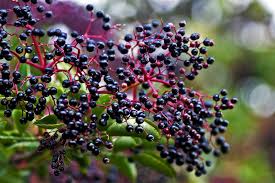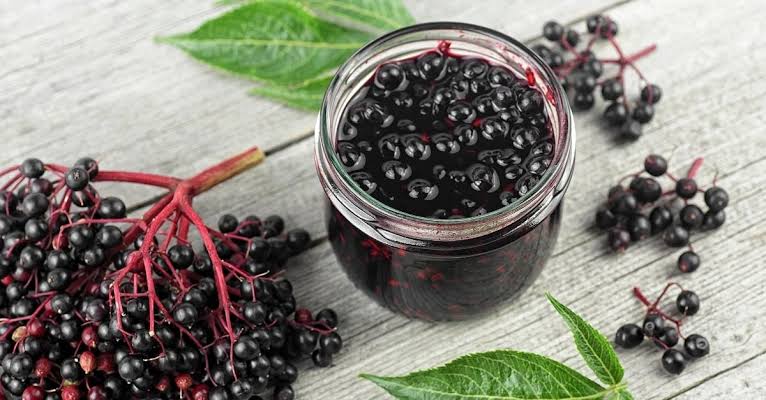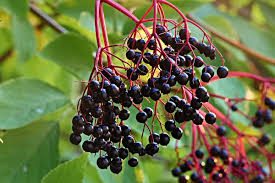Elderberries scientifically known as Sambucus nigra are small, dark purple fruits that come from the elder tree. These berries are not just tasty; they are also packed with goodness for our bodies. People have been using elderberries for a very long time, even way back in history.
One of the fantastic things about elderberries is that they are rich in vitamins. These little berries have a lot of vitamin C, which helps keep our immune system strong. When the flu season comes around, sipping on elderberry tea or enjoying elderberry syrup might give us that extra boost we need to stay healthy.
Apart from vitamin C, elderberries also have antioxidants. Antioxidants are like tiny superheroes that protect our cells from damage. So, when we eat elderberries, it’s like giving our bodies a shield against harmful things.
Many folks like to make elderberry jam or jelly. It’s a sweet treat that not only tastes delicious but also brings the goodness of elderberries to our breakfast table. Imagine spreading elderberry jam on your morning toast – a tasty way to start the day!
Some people use elderberries to make refreshing drinks. Elderberry juice is not only flavorful but also a great way to stay hydrated. You can mix it with water or other juices to create your own special concoction.
But it’s not just the berries that are useful; even the flowers of the elder tree have their own charm. Elderflower tea is a soothing beverage that some people enjoy for relaxation. The delicate aroma of elderflowers can turn a simple cup of tea into a calming experience.
Elderberries have also found their way into traditional medicine. Some folks believe that elderberry can help with colds and flu symptoms. While it’s essential to consult with a healthcare professional, many appreciate the natural touch that elderberries bring to wellness routines.
In addition, elderberries are more than just tasty fruits – they’re like tiny health bombs. From vitamin C to antioxidants, these berries offer a range of benefits. So, the next time you see elderberry products on the shelf, consider giving them a try. Your taste buds and your body might just thank you for it!
Read Also: How to Raise Backyard Chickens
The History of Elderberries (Sambucus nigra)

Elderberries have a long and fascinating history, intertwined with human traditions and folk remedies. Throughout the ages, people have recognized the unique qualities of these dark purple berries and utilized them in various ways.
In ancient times, elderberries were not just seen as a tasty fruit but also held symbolic importance. Some cultures believed that elder trees had protective spirits, and elderberries were used in rituals to ward off evil spirits. This sacred connection contributed to the reverence that elderberries held in different societies.
As time progressed, elderberries became a staple in traditional medicine. Historical records indicate the use of elderberries to address various ailments, ranging from colds to inflammation. Folk healers often turned to elderberry-based concoctions to provide relief and support to those in need.
In medieval Europe, elderberries found their way into culinary delights. They were used in pies, jams, and beverages, adding a burst of flavor to the daily fare. The versatility of elderberries made them a valuable ingredient in kitchens across the continent.
During the Renaissance, herbalists and botanists began to document the medicinal properties of plants, including elderberries. Their writings highlighted the potential health benefits of these berries, contributing to the growing knowledge about herbal remedies.
In the 20th century, elderberries gained popularity once again, with a renewed interest in natural and holistic approaches to health. Researchers began studying the compounds present in elderberries, shedding light on their antioxidant properties and immune-boosting potential.
Today, elderberries continue to be celebrated for their nutritional value. From elderberry syrups to teas and supplements, modern consumers have a variety of ways to incorporate these berries into their lifestyles. The rich history of elderberries, spanning cultures and centuries, is a testament to the enduring appeal and significance of this small but mighty fruit.
Read Also: Best Source of Water for Poultry Birds
The Nutritional Values of Elderberries (Sambucus nigra)

Elderberries boast an impressive array of nutritional values that contribute to their status as a healthful fruit. Here’s a glimpse into the goodness packed within these small, dark purple berries:
1. Vitamins: Elderberries are rich in vitamin C, an essential nutrient known for its immune-boosting properties. Adequate vitamin C intake is vital for overall health, and elderberries provide a tasty way to meet a portion of this requirement.
2. Antioxidants: Elderberries are loaded with antioxidants, such as flavonoids and anthocyanins. These compounds act as defenders against oxidative stress, helping to protect cells from damage caused by free radicals.
3. Dietary Fiber: Elderberries contain dietary fiber, promoting digestive health by aiding in regular bowel movements. Fiber also contributes to a feeling of fullness, which can be beneficial for those managing their weight.
4. Minerals: Elderberries provide essential minerals like potassium and iron. Potassium is crucial for maintaining a healthy balance of fluids in the body, while iron is essential for the formation of red blood cells and oxygen transport.
5. Phytochemicals: The phytochemicals in elderberries contribute to their anti-inflammatory and anti-viral properties. These natural compounds may play a role in supporting overall well-being.
6. Low in Calories: Elderberries are relatively low in calories, making them a nutritious addition to various diets. Their natural sweetness can also be a healthier alternative for those seeking a sweet treat.
It’s important to note that while elderberries offer these nutritional benefits, it’s advisable to consume them as part of a balanced diet. As with any food or supplement, moderation is key. If considering elderberry supplements or extracts, it’s recommended to consult with a healthcare professional, especially for individuals with underlying health conditions or those taking medications.
The Health Benefits of Elderberries (Sambucus nigra)

Elderberries are celebrated for their potential health benefits, making them more than just a tasty addition to your diet. Here are some of the positive aspects associated with consuming elderberries:
1. Immune Support: One of the most well-known health benefits of elderberries is their potential to support the immune system. The high vitamin C content and antioxidant properties may help strengthen the body’s defenses against common illnesses.
2. Antioxidant Power: Elderberries are rich in anthocyanins, flavonoids, and other antioxidants that combat oxidative stress. These compounds contribute to cellular health by neutralizing free radicals, potentially reducing the risk of chronic diseases.
3. Anti-Inflammatory Properties: The presence of anti-inflammatory phytochemicals in elderberries may help alleviate inflammation in the body. This could be beneficial for conditions where inflammation plays a role, such as arthritis or certain respiratory issues.
4. Heart Health: Elderberries contain potassium, which is associated with heart health. Adequate potassium intake helps regulate blood pressure and supports cardiovascular function, potentially reducing the risk of heart-related issues.
5. Cold and Flu Relief: Traditional uses of elderberries include easing symptoms of the common cold and flu. Some studies suggest that elderberry extracts may help reduce the duration and severity of these illnesses, although more research is needed to confirm these effects.
6. Digestive Health: The dietary fiber found in elderberries supports a healthy digestive system by promoting regular bowel movements. Fiber also contributes to a feeling of fullness, which can be beneficial for weight management.
7. Skin Health: The antioxidants in elderberries may contribute to healthier skin by protecting against environmental damage. Some skincare products include elderberry extracts for their potential anti-aging and skin-soothing properties.
It’s crucial to remember that while elderberries offer these potential health benefits, individual responses may vary. Also, incorporating elderberries into a well-balanced diet is key, and consulting with a healthcare professional is advisable, especially for those with specific health concerns or conditions.
How to Grow Elderberries (Sambucus nigra)
Growing elderberries can be a rewarding venture, providing you with a fresh supply of these nutritious berries. Here’s a basic guide on how to grow elderberries:
1. Choose the Right Variety: There are different varieties of elderberries, so choose one that suits your climate and space. Common types include Sambucus nigra (European elderberry) and Sambucus canadensis (American elderberry).
2. Select a Suitable Location: Elderberries prefer full sun but can tolerate partial shade. Ensure the chosen location has well-drained soil, as elderberries don’t like their roots sitting in water.
3. Planting: Plant elderberries in late fall or early spring. Space plants about 6 feet apart. Dig a hole large enough to accommodate the roots and add compost to the soil for nutrient enrichment.
4. Watering: While elderberries are drought-tolerant once established, they benefit from regular watering, especially during dry spells. Ensure the soil stays consistently moist but not waterlogged.
5. Pruning: Prune elderberries to encourage a strong, open framework. Remove dead or damaged wood and cut back older stems to stimulate new growth. Regular pruning helps maintain a healthy plant structure.
6. Fertilizing: Elderberries generally don’t require much fertilizer. A balanced, slow-release fertilizer in spring should be sufficient. Too much nitrogen can lead to excessive vegetative growth at the expense of fruiting.
7. Mulching: Apply a layer of organic mulch around the base of the plants to conserve moisture, suppress weeds, and provide nutrients as it breaks down.
8. Harvesting: Elderberries typically ripen in late summer to early fall. Harvest the clusters of berries when they are fully dark and have a slight waxy bloom. Be cautious, as elderberries are toxic when unripe.
9. Pests and Diseases: Keep an eye out for pests like aphids and mites. Elderberries can be susceptible to certain diseases, so proper sanitation and good airflow can help prevent issues.
10. Propagation: Elderberries can be propagated through hardwood cuttings or suckers. This allows you to expand your elderberry patch or share plants with others.
Remember that elderberries may take a year or two to start producing a substantial harvest, but with proper care, they can become a reliable part of your home garden. Always refer to local gardening guidelines and consider seeking advice from experienced gardeners in your area for the best results.
Read Also: Low-Maintenance Plants for Beginners
